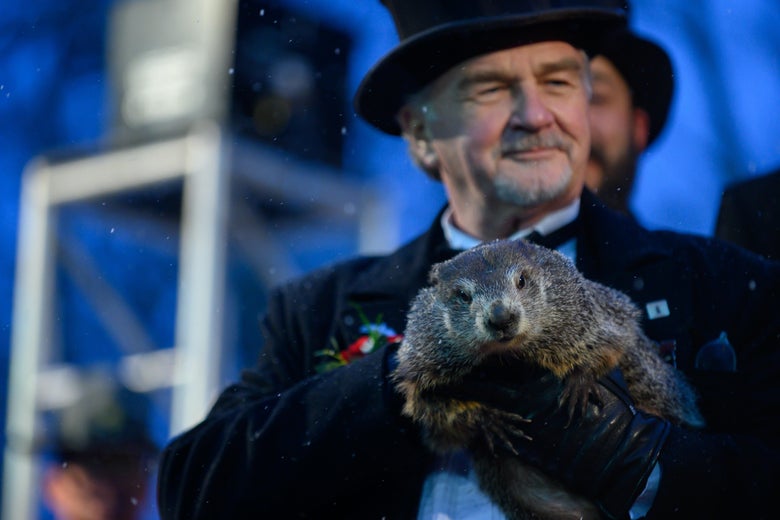
Groundhog handler John Griffiths holds Punxsutawney Phil, who did not see his shadow, predicting an early or late spring during the 134th annual Groundhog Day festivities on February 2, 2020 in Punxsutawney, Pennsylvania.
Jeff Swensen/Getty Images
Across much of the United States, many have been enjoying a mild winter. And if the world’s most famous groundhog is to be believed, the trend will continue and there will be an early spring. In fact, on Sunday morning, Punxsutawney Phil declared that early spring “is a certainty.” Well, obviously the groundhog didn’t actually declare anything but that didn’t matter to the thousands of people who gathered at sunrise on Sunday to watch as Phil emerged from his den in Punxsutawney, Pa. The groundhog allegedly did not see his shadow, according to members of his “inner circle,” meaning there will be an early spring. According to legend, if he had seen his shadow it would have signified six more weeks of winter.
Lauren Edwards, 7, and her brother, Matthew, 11, from Downington, Pennsylvania await the arrival of Punxsutawney Phil during the 134th annual Groundhog Day festivities on February 2, 2020 in Punxsutawney, Pennsylvania.
Jeff Swensen/Getty Images
The top-hat wearing members of Phil’s “inner circle” take part in the elaborate ceremony every year in which they read a prediction that had already been made in advance. “Now my forecast on a day that’s a palindrome will cause some to cheer and some to moan. So do I hope you think it’s neighborly, for there is no shadow of me, spring it’ll be early, it’s a certainty,” a member of Phil’s “inner circle” read from the prediction scroll as the crowd cheered.
Since Phil’s weather-predicting career began in 1887, he has seen his shadow 104 times and has failed to see it on a mere 20 instances (a few years are missing from the official record). That makes this year’s prediction relatively rare and marks the first time Phil hasn’t seen his shadow two years in a row.
Phil’s forecast “seems fitting considering the lack of winter weather this winter so far,” notes the Washington Post. But truth be told, Phil doesn’t have the best track record. From 2010-2019, Phil predicted a longer winter seven times and an early spring three times. He was right only 40 percent of the time, according to the National Oceanic and Atmospheric Administration. He has been on a particularly poor streak lately as Phil got it wrong the past three years. Don’t be too hard on him though because, as the NOAA notes, “predicting the arrival of spring for an entire country, especially one with such varied regional climates as the United States, isn’t easy!”
Readers like you make our work possible. Help us continue to provide the reporting, commentary and criticism you won’t find anywhere else.
Join Slate Plusfrom Slate Magazine https://ift.tt/37RTLpO
via IFTTT
沒有留言:
張貼留言